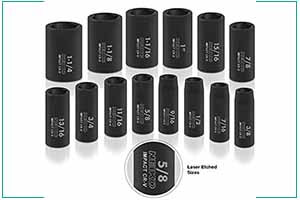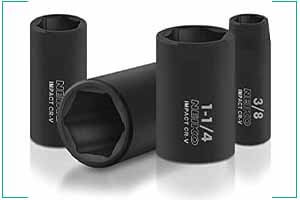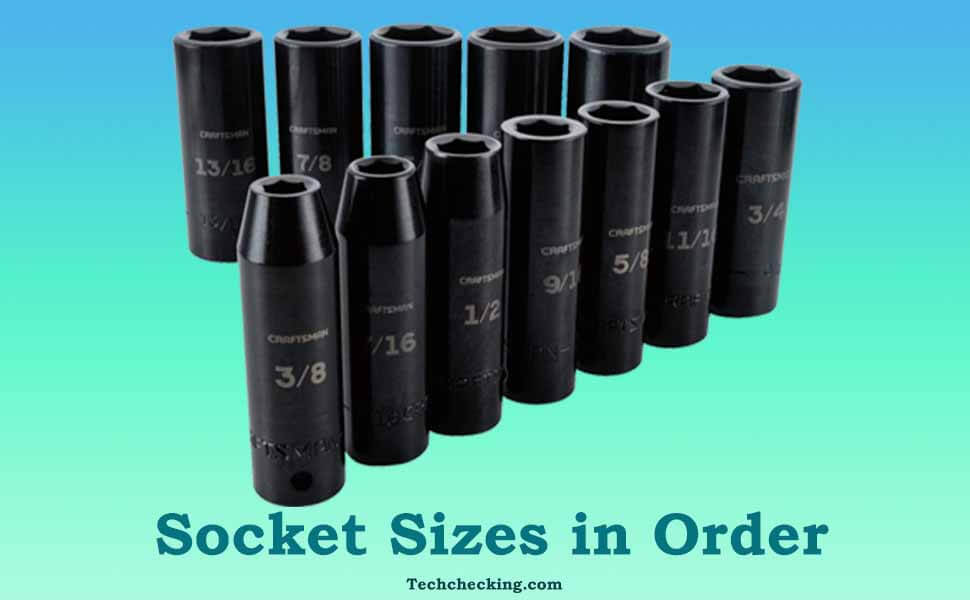Last Updated on January 11, 2023 by TechChecking
Any professional who needs to repair their home, shop, or even vehicle requires some kind of specific tools. Socket wrenches are one of them. If you already know about the wrench sizes in order, this is high time you learned about socket sizes in order as well. There are many sizes of socket wrenches that are important to know. In this article, you will learn more about the different types of socket sizes in order with proper charts.
Before knowing the standard socket sizes in order, it is very necessary to know the most common drive sizes. This will help to know and learn the other parts easily and quickly. So, what are the most common drive sizes?
Contents
Most Common Drive Sizes
There are many different types of nuts or bolts out in the market. Due to various sizes of nuts and bolts, different socket drive sizes are required. In our daily life, we commonly find 3 standard drives sizes for our jobs. Most of the time you can find one of them fit for a wrench or a ratchet. The three common drive sizes are:
1/2″ Drives – this is one of the biggest sizes drive of the three we are going to discuss. As this 1/2-inch drive is larger compared to other common drive sizes, it is able to produce more torque and power. This is how you can do heavy-duty work. The 1/2-inch drives are usually used for fastening or unfastening nuts or bolts from cars or bigger vehicles or factories.
3/8″ Drives – the 3/8-inch drives are very versatile and multifunctional. This size of sockets is incredibly useful to cover sockets and areas for different types of jobs. Either a professional or a DIY project manager for repairing or building workshops, homes, lawns, or yards can pick this 3/8-inch drive. Smaller to medium-level jobs are ideal for this type of drive.
1/4″ Drives – if you are willing to do some low torque jobs, the 1/4″ drives are appropriate for it. Due to the drive’s tininess, it will produce low torque and this is how you can do these normal jobs with this ¼-inch drive. With a maximum size of 14mm socket size, you can use this socket for precision or interior jobs.
Types of Sockets

Knowing besides socket sizes in order, you should also know the types of sockets if you are a professional worker. The more you know your tools, the better you can use them. Do you wonder, what are the socket sizes in order or what is the order of wrench sizes?? If you want to get full and detailed information with images about different types of socket wrenches, you can find many resources. So, let’s know some of them here.
Impact Sockets
Want to save your time and energy? Well, impact sockets are here to make your job done easily and faster. A few years back people used to prefer hand tools because they are strong and sturdy. Impact sockets these days are also quality built and durable to last long. However, the most important feature of impact sockets is that they are specially designed to fit in such tools. So, impact sockets are important. For example – if you are working with a pneumatic or electric wrench that requires some sort of specific sockets that must be sturdy and can withstand high torques. The pneumatic wrench along with these impact sockets can get the job done perfectly as it can undergo in any robust situation.
Point Sockets
Point sockets are kinds of sockets that have 12 contact points to grip perfectly. They are very easy to fit and handy to use. Since fitting as well as using the wrench with the sockets are so easy, a starter can easily use it. Yes, nobody faces an alignment problem. You can try it.
Besides 12 points sockets, there are 6 points sockets are available too. A 6-point socket is used for heavy-duty jobs and this is why they need heavy or substantial torque.
Between the two sockets (12 points sockets and 6 points sockets), the 6 point sockets are durable and sturdier. However, they are less likely to slip. So you can understand now if you have a lightweight job, go for the 12 points sockets, and if it is truly a heavy-duty job, a 6-point socket is second to none.
Shallow vs Deep Sockets
A shallow socket is a normal or conventional socket. In some cases, a shallow socket might not touch the nut before the bolt hits the end of the socket. Since the nut cannot reach the end of the socket, the job becomes remarkably hard and, truth be told, sometimes undoable. To handle this kind of situation, a professional uses deep sockets. So, using deep sockets in inaccessible places can solve this problem. In addition, you can also do this if you have an extension of the driver.
It is essential to know the different sizes of sockets in order so that you can easily understand and pick the right one quickly. We will gradually show here the Metric Socket Sizes Chart, SAE Socket Sizes Chart, and SAE to Metric Conversion Chart. We will discuss imperial socket sizes in order and socket sizes in order from smallest to largest, These charts will help you enrich your knowledge. So, let’s see the list socket sizes in order.
Metric Socket Sizes In Order Chart
So, now let’s know the different sizes of Metric Socket Sizes. This chart will help you pick the desired socket. This chart is about the metric socket sizes in order.
| 1/4” Drive | 3/8” Drive | 1/2” Drive | 3/4” Drive | 1” Drive |
| 4mm | 5.5mm | 8mm | 19mm | 36mm |
| 4.5mm | 6mm | 9mm | 20mm | 38mm |
| 5mm | 7mm | 10mm | 21mm | 41mm |
| 5.5mm | 8mm | 11mm | 22mm | 46mm |
| 6mm | 9mm | 12mm | 23mm | 50mm |
| 7mm | 10mm | 13mm | 24mm | 54mm |
| 8mm | 11mm | 14mm | 25mm | 55mm |
| 9mm | 12mm | 15mm | 26mm | 58mm |
| 10mm | 13mm | 16mm | 27mm | 60mm |
| 11mm | 14mm | 17mm | 28mm | 63mm |
| 12mm | 15mm | 18mm | 29mm | 65mm |
| 13mm | 16mm | 19mm | 30mm | 67mm |
| 14mm | 17mm | 20mm | 31mm | 70mm |
| 15mm | 18mm | 21mm | 32mm | 71mm |
| 19mm | 22mm | 33mm | 75mm | |
| 20mm | 23mm | 34mm | 77mm | |
| 21mm | 24mm | 35mm | 80mm | |
| 22mm | 25mm | 36mm | ||
| 26mm | 38mm | |||
| 27mm | 40mm | |||
| 28mm | 41mm | |||
| 30mm | 42mm | |||
| 32mm | 45mm | |||
| 46mm | ||||
| 48mm | ||||
| 50mm |
SAE Socket Sizes In Order Chart
As we already know the different metric socket sizes, this is high time we learned about different SAE Socket Sizes In order. Let’s see the chart of socket sizes in order SAE.
| 1/4” Drive | 3/8” Drive | 1/2” Drive | 3/4” Drives | 1” Drives |
| 5/32″ | 1/4″ | 3/8″ | 7/8″ | 1-5/8″ |
| 3/16″ | 5/16″ | 7/16″ | 15/16″ | 1-11/16″ |
| 7/32″ | 3/8″ | 1/2″ | 1″ | 1-3/4″ |
| 1/4″ | 7/16″ | 9/16″ | 1-1/16″ | 1-13/16″ |
| 9/32″ | 1/2″ | 19/32″ | 1-1/8″ | 1-7/8″ |
| 5/16″ | 9/16″ | 5/8″ | 1-3/16″ | 2″ |
| 11/32″ | 5/8″ | 21/32″ | 21/32″ | 2-1/8″ |
| 3/8″ | 11/16″ | 11/16″ | 1-5/16″ | 2-3/16″ |
| 7/16″ | 3/4″ | 3/4″ | 1-3/8″ | 2-1/4″ |
| 1/2″ | 13/16″ | 25/32″ | 1-7/16″ | 2-3/8″ |
| 9/16″ | 7/8″ | 13/16″ | 1-1/2″ | 2-1/2″ |
| 15/16″ | 7/8″ | 1-5/8″ | 2-5/8″ | |
| 1″ | 15/16″ | 1-11/16″ | 2-3/4″ | |
| 1″ | 1-3/4″ | 2-15/16″ | ||
| 1-1/16″ | 1-13/16″ | 3″ | ||
| 1-1/8” | 1-7/8” | 3-1/8” | ||
| 1-3/16″ | 2″ | |||
| 1-1/4” | 2-1/8” | |||
| 1-1/2″ | 2-3/16″ | |||
| 2-1/4” |
SAE to Metric Conversion Chart
We have already learned the metric socket sizes and the SAE socket sizes. What if you have metric socket size but need to convert it into SAE size? Well, we are now going to learn the chart that helps to SAE to Metric system. So, you can easily convert from SAE to metric and vice-versa.
| SAE Size | Metric Size | Inches Decimal | |
| 5/32″ | 0.156 | 5/32″ and 4mm are close enough | |
| 4mm | 0.157 | ||
| 4.5mm | 0.177 | ||
| 3/16″ | 0.188 | ||
| 5mm | 0.197 | ||
| 5.5mm | 0.216 | ||
| 7/32″ | 0.219 | ||
| 6mm | 0.236 | ||
| 1/4″ | 0.250 | ||
| 6.5mm | 0.256 | ||
| 7mm | 0.276 | ||
| 9/32″ | 0.281 | ||
| 5/16″ | 0.313 | 5/16″ and 8mm are close enough | |
| 8mm | 0.315 | ||
| 11/32″ | 0.344 | ||
| 9mm | 0.354 | ||
| 3/8″ | 0.375 | ||
| 10mm | 0.394 | ||
| 13/32″ | 0.406 | ||
| 11mm | 0.433 | ||
| 7/16″ | 0.438 | 7/16″ and 11mm are close enough | |
| 15/32″ | 0.469 | 15/32″ and 12mm are close enough | |
| 12mm | 0.472 | ||
| 1/2″ | 0.500 | ||
| 13mm | 0.512 | ||
| 17/32″ | 0.531 | ||
| 14mm | 0.551 | ||
| 9/16″ | 0.563 | ||
| 15mm | 0.591 | ||
| 19/32″ | 0.594 | 19/32″ and 15mm are close enough | |
| 5/8″ | 0.625 | 5/8″ and 16mm are close enough | |
| 16mm | 0.630 | ||
| 21/32″ | 0.656 | ||
| 17mm | 0.669 | ||
| 11/16″ | 0.688 | ||
| 18mm | 0.709 | ||
| 23/32″ | 0.719 | ||
| 19mm | 0.748 | ||
| 3/4″ | 0.750 | 3/4″ and 19mm are close enough | |
| 25/32″ | 0.781 | ||
| 20mm | 0.787 | ||
| 13/16″ | 0.813 | ||
| 21mm | 0.827 | ||
| 27/32″ | 0.844 | ||
| 22mm | 0.866 | ||
| 7/8″ | 0.875 | ||
| 23mm | 0.906 | ||
| 29/32″ | 0.906 | 29/32″ and 23mm are close enough | |
| 15/16″ | 0.938 | ||
| 24mm | 0.945 | ||
| 25mm | 0.984 | ||
| 1″ | 1.000 | ||
| 26mm | 1.024 | ||
| 1-1/16″ | 1.063 | 1-1/16″ and 27mm are close enough | |
| 27mm | 1.063 | ||
| 28mm | 1.102 | ||
| 1-1/8″ | 1.125 | ||
| 29mm | 1.142 | ||
| 30mm | 1.181 | ||
| 1-3/16″ | 1.188 | ||
| 31mm | 1.220 | ||
| 1-1/4″ | 1.250 | ||
| 32mm | 1.260 | ||
| 33mm | 1.299 | ||
| 1-5/16″ | 1.313 | ||
| 34mm | 1.339 | ||
| 1-3/8″ | 1.375 | 1-3/8″ and 35mm are close enough | |
| 35mm | 1.378 | ||
| 36mm | 1.417 | ||
| 1-7/16″ | 1.438 | ||
| 37mm | 1.457 | ||
| 38mm | 1.496 | ||
| 1-1/2″ | 1.500 | 1-1/2″ and 38mm are close enough |
This socket size chart would be more useful if you use a non-metric socket on nuts of around 14mm, 17mm, or larger. The chart has been maintained the socket sizes in order.
Socket Drive Sizes

Socket drive sizes are important to know because the more you know about your tools, the more you will be professional. There are 5 different sizes of socket drive are out there. They are 1/4″, 3/8″, 1/2″, 3/4″, and 1″. These socket drive sizes are commonly used for various jobs.
The simple theory is – the smaller the socket drive is, the smaller the head should be.
Socket Sizes in Order from Smallest to Largest
¼” Socket Drive – this is the smallest size of the 5 sizes of socket drives. You can use it for low torque, precision, or interior work.
3/8” Socket Drive – this one is one of the most versatile tools of those 5 sizes. It will fit in spots even if the 1/2″ drive won’t. You can also use 12mm to 18mm sockets as well. You may know spark plug sockets almost always require a 3/8″ drive.
½” Socket Drive – the ½-inch socket drive is used for heavy-duty work. They are strong and sturdy. Ideal for factory or industry-related jobs. Besides, you can use this one to install a flat-screen TV.
3/4” Socket Drive – this size socket drive is the second-best bigger size of the 5 sizes of sockets. As we are going socket sizes in order from smallest to largest, you will see this one as large size. Good for heavy-duty works.
1” Socket Drive – the 1-inch socket drive is the largest one in all of them. You can use it for fastening or unfastening very big nuts and bolts. Know more from here.
Let’s see these in a chart. There is some overlap between the socket head sizes that are available with different sized ‘drive sockets’.
| Drive Socket Size | Metric Socket Head Sizes Available | Imperial Socket Head Sizes Available |
| 1/4″ | 3, 3.2, 3.5, 4, 4.5, 5, 5.5, 6, 7, 8, 9, 10, 11, 12, 13, 14mm | 5/32, 3/16, 7/32, 1/4, 9/32, 5/16, 11/32, 3/8, 7/16, 1/2″ |
| 3/8″ | 5.5, 6, 7, 8, 9, 10, 11, 12, 13, 14, 15, 16, 17, 18, 19, 20, 21, 22mm | 1/4, 5/16, 11/32, 3/8, 7/16, 1/2, 9/16, 5/8, 11/16, 3/4, 13/16, 7/8″ |
| 1/2″ | 8, 9, 10, 11, 12, 13, 14, 15, 16, 17, 18, 19, 20, 21, 22, 23, 24, 25, 26, 27, 28, 30, 32mm | 3/8, 7/16, 1/2, 9/16, 5/8, 11/16, 3/4, 13/16, 7/8, 15/16, 1, 1-1/16, 1-1/8, 1-3/16, 1-1/4″ 3/4″ |
| 3/4″ | 19, 22, 24, 26, 27, 28, 30, 32, 34, 36, 38, 41, 42, 45, 46, 48, 50mm | 5/16, 1-1/8, 1-3⁄16, 1-1/4, 1-5/16, 1-3/8, 1-7/16, 1-1/2, 1-5/8, 1-3/4” |
| 1″ | 36, 38, 41, 46, 50, 54, 55, 58, 60, 63, 65, 67. 70, 71, 75, 77, 80mm | 15/16, 1, 1-1/16, 1-1/8, 1-1/4, 1-5/16, 1-1/2″ |
Final Words
In this article “Socket Sizes in Order”, we have tried to explain in the simplest way to make you understand. This also describes the socket sizes in order from smallest to largest. You can see the chart and try to understand it. They are very useful. If you think you need the socket sizes in order from largest to smallest, actually they are all the same. If you have anything to ask, you can reach out to us. Thank you.

